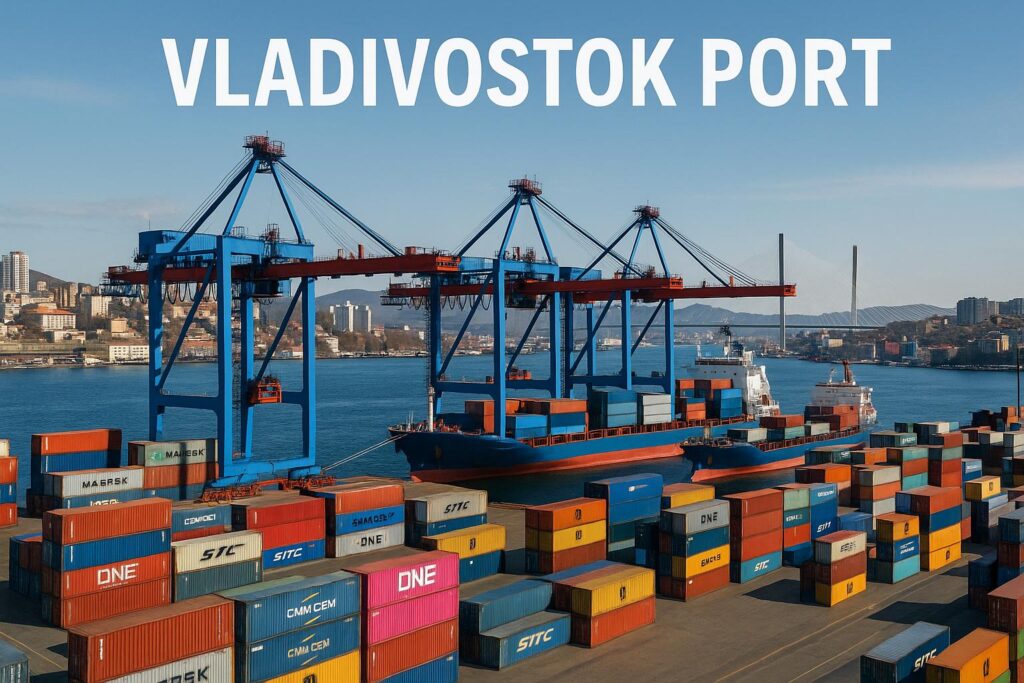Introduction: Vladivostok Port – Gateway to Eastern Russia
Vladivostok Port, located on the scenic shores of Golden Horn Bay in the Russian Far East, serves as a vital maritime and cultural link between Russia and the Asia-Pacific region. Known as the official gateway to Eastern Russia, this deep-water port plays a crucial role in facilitating trade, tourism, and education, while connecting the territory of Primorsky Krai with major economic hubs such as China, Japan, and South Korea.
As the administrative center of the city of Vladivostok, the port supports both commercial and passenger operations. Cargo terminals handle a diverse range of goods—from automobiles and machinery to seafood like sea cucumbers—while ferry and cruise services welcome thousands of tourists each year. Its strategic location, combined with its free port status, has made it a preferred destination for foreign citizens and international businesses seeking new opportunities in the Far East.

Historical Development of Vladivostok Port
Foundations in the Russian Empire Era
The origins of Vladivostok Port trace back to the mid-19th century, during the expansion of the Russian Empire into the Far East. Recognizing the value of a warm-water port on the Pacific Ocean, the Russian government established Vladivostok as a military outpost and commercial harbor. This move secured Russia’s presence in Northeast Asia and enabled greater participation in regional trade.
In its early years, the port was instrumental in supplying Russian settlements and supporting naval operations. Its position near China, Korea, and Japan allowed it to act as both a trading hub and a defensive stronghold. The city’s early infrastructure—including its first train station—was built to connect the harbor with inland regions and lay the foundation for future integration with the Trans-Siberian Railway.
Vladivostok During the Soviet Times
Under the Soviet Union, Vladivostok became one of the most strategically important ports in the country. During Soviet times, it served as the headquarters of the Pacific Fleet and was a restricted territory closed to most foreigners. The Soviet government invested heavily in port infrastructure, expanding berths, warehouses, and ship repair facilities.
Despite being closed to the outside world, the port played a crucial role in maritime logistics, supplying military bases and supporting domestic shipping routes. Its shipyards produced vessels for both military and civilian use, cementing Vladivostok’s reputation as a major industrial center in the Russian Far East.
Vladivostok in the Cold War Era
During the Cold War, Vladivostok Port was both a symbol of Soviet maritime power and a geopolitical flashpoint in the Pacific Ocean region. Positioned close to Japan, China, and the Korean Peninsula, the city was heavily fortified and served as a key observation point for monitoring Asia-Pacific naval activities.
Although closed to foreign citizens at the time, Vladivostok maintained limited contact with allied countries through controlled trade agreements. The period also saw significant investments in transportation infrastructure, further integrating the port with Moscow and Lake Baikal via the Trans-Siberian Railway.
Geographical Advantage of Vladivostok Port
Strategic Location in the Asia-Pacific
Vladivostok is uniquely positioned at the crossroads of the Asia-Pacific shipping routes. Located on the shores of Amur Bay and Golden Horn Bay, it offers direct access to the Pacific Ocean and lies within short sailing distance of major ports in China, Japan, and South Korea. This proximity enables efficient maritime connections and positions Vladivostok as a central hub for regional trade.
Proximity to Key Countries and Cities
From Vladivostok, cargo ships can reach countries across Northeast Asia in just a few days, making it a preferred choice for businesses seeking to minimize transit times. The city’s closeness to Beijing, Tokyo, and Seoul enhances its appeal as a gateway for both imports and exports, while also supporting passenger services such as international flights and ferry routes.
Integration with Natural and Cultural Landmarks
The port is not only an economic center but also surrounded by scenic attractions. Russky Island, connected by the impressive Russky Bridge, is a popular destination for tourists and foreign citizens. Nearby cultural institutions, such as the Primorsky State Art Gallery and various museums, add to the city’s appeal, encouraging cruise ship operators to include Vladivostok in their Asia-Pacific itineraries.
Port Infrastructure and Cargo Handling Capacity
Modern Facilities and Terminals
Vladivostok Port boasts multiple deep-water berths capable of accommodating large container ships, bulk carriers, and specialized cargo vessels. The container terminal is equipped with modern cranes, automated storage systems, and refrigerated warehouses for perishable goods like sea cucumbers and seafood exports. These facilities ensure quick turnaround times and reliability for businesses involved in time-sensitive logistics.
Cargo Diversity and Specialized Handling
The port handles a wide range of goods, including automobiles, construction materials, timber, and manufactured products from China and other countries. Specialized terminals process oil, coal, and bulk commodities, while passenger terminals host ferry and cruise services. This diversity allows Vladivostok to remain resilient against fluctuations in global trade.
Free Port Advantages for International Trade
Since being granted free port status, Vladivostok has offered tax incentives and simplified customs clearance procedures for foreigners and international companies. This policy attracts investment from the Asia-Pacific region, strengthens economic ties, and creates new opportunities for businesses in sectors like shipbuilding, logistics, and tourism.
Integration with the Trans-Siberian Railway
Seamless Maritime–Railway Connectivity
One of Vladivostok Port’s greatest strengths is its direct link to the Trans-Siberian Railway, a 9,000-kilometer route connecting the Pacific Ocean to Moscow and Europe. This integration allows cargo arriving at Golden Horn Bay to be swiftly transferred onto trains serving destinations across the entire territory of Russia.
Linking the Far East to Lake Baikal and Beyond
The railway connection makes it possible for goods to travel from the Russian Far East to Lake Baikal, Siberia’s industrial centers, and major cities in western Russia. This reduces delivery times for businesses in China, Japan, and South Korea, making Vladivostok an efficient alternative to longer maritime routes through the Suez Canal.
Supporting Trade Across Borders
The port–railway combination also facilitates trade between the Far East and countries in Central Asia and Eastern Europe. For exporters, this means faster delivery to markets and fewer logistical hurdles, while importers benefit from reduced transportation costs.
Learn more:
Rail Freight from China to Russia
Road Freight from China to Russia
How Long Does It Take to Ship from China to Russia
Shipping Costs for 20ft & 40ft Containers from China to Russia
Rail freight vs sea freight: China to Russia
Cheapest Air Shipping from China to Russia

Economic Role in Eastern Russia
Driving Regional Development
Vladivostok Port plays a crucial role in the economy of Primorsky Krai and the Russian Far East. Its free port status has encouraged investment from foreign citizens, multinational corporations, and businesses in sectors ranging from logistics and manufacturing to tourism.
Tourism and Cultural Exchange
Beyond commerce, the port contributes significantly to tourism. Thousands of tourists arrive each year via cruise ships and ferries, drawn to attractions such as Russky Island, Amur Bay, and the Primorsky State Art Gallery. The city’s rich culture—influenced by its proximity to China, Japan, and Korea—is showcased in its museums, architecture, and local cuisine.
Educational and Academic Impact
Institutions like Far Eastern Federal University and Vladivostok State University bring together Russian students and foreigners from around the world. These universities foster international cooperation, encourage research in maritime logistics, and help develop the skilled workforce needed to support the port’s ongoing expansion.
Supporting Local Businesses
The port sustains thousands of jobs in shipping, warehousing, ship repair, and related industries. Local businesses benefit from the steady flow of goods, while service sectors such as hospitality, retail, and cultural tourism gain from the influx of visitors.
Future Development and Investment Opportunities
Government-Led Infrastructure Expansion
The Russian government has prioritized Vladivostok as a strategic development zone in the Russian Far East. Plans include expanding existing berths, upgrading the container terminal, and deepening channels to handle larger vessels from the Pacific Ocean. New logistics facilities are being established to accommodate the growing needs of businesses engaged in regional trade.
Attracting Foreign Investment
The city’s free port policy offers significant tax benefits and simplified customs clearance processes, drawing interest from countries across the Asia-Pacific and beyond. Investments from China, Japan, and South Korea are expected to enhance port capacity, introduce new shipping technologies, and create high-value jobs for the local population.
Tourism and Cultural Growth
The port is increasingly integrated into the city’s tourism strategy, with redevelopment projects aimed at improving waterfront areas, cruise ship terminals, and public spaces. This will support the arrival of more tourists eager to experience the city’s life, vibrant culture, and rich history. Attractions like museums, art galleries, and guided tours of historic districts are being promoted to enhance visitor engagement.
Strengthening Education and Research
Partnerships between the port authority and local universities, such as Far Eastern Federal University, aim to develop programs in maritime engineering, logistics management, and environmental sustainability. These initiatives prepare Russian students and foreign citizens to participate in the port’s long-term growth.
Conclusion: Vladivostok Port’s Role in Connecting East and West
Vladivostok Port’s journey—from its beginnings in the Russian Empire to its modern role as a gateway to Eastern Russia—reflects its enduring strategic and economic importance. Situated on Golden Horn Bay, near Amur Bay and Russky Island, and linked to the Trans-Siberian Railway, the port connects Russia to the world, bridging the Far East and Europe.
Its crucial role spans multiple sectors: driving regional development, fostering cultural exchange, supporting businesses, and attracting tourists from across the Asia-Pacific. The combination of maritime access, railway integration, and free port benefits ensures that Vladivostok remains a competitive hub for global trade.
Looking ahead, ongoing infrastructure upgrades, international partnerships, and cultural initiatives will secure Vladivostok’s position as a leading port in the Russian Far East. For investors, shipping companies, and travelers alike, it stands as a living symbol of Russia’s connection to both the East and the West—anchored in history, yet poised for a dynamic future.

